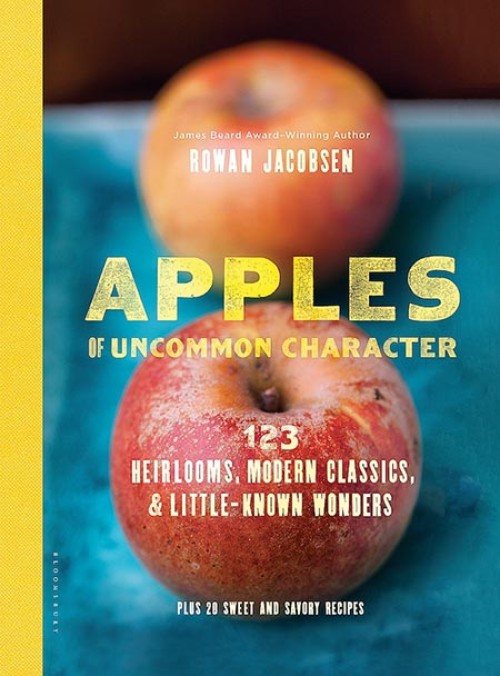by Rowan Jacobsen
Bloomsbury, New York, 2014
Apples are so common that it is easy to mistake them for commonplace. In Apples of Uncommon Character: 123 Heirlooms, Modern Classics, and Little-Known Wonders, Rowan Jacobsen entertainingly proves just the opposite. For more than two centuries, thousands of varieties of apples have sustained homesteads across the continent, only to dwindle over time to a handful of varieties that were easy to store, easy to transport, and easy on the eyes. Fortunately, we are in the midst of an apple renaissance and, Jacobsen tells us, “we have more varieties of extraordinary apples within reach…than any people who have come before us.”
For Jacobsen, a well-established writer with several books and two James Beard Awards for excellence in food writing behind him, the moment of apple enlightenment came a decade ago when he and his wife bought an 1840s farmhouse in Calais, Vermont, with an old orchard beside it. Having previously lost interest in the apples generally available in supermarkets, he was intrigued by the unusual trees he now owned:
“But the apples hanging in these trees didn’t look like any I’d ever seen in a store. In one tree, they were large, round, and striped red and yellow like little beach balls. In another, they were brown and fuzzy, more like miniature Asian pears than what I thought an apple was supposed to be. I tried one. It was strangely dry, yet very sweet, crunchy, and nutty...”
Unlike most fruit trees, apples can flourish even when uncared for, so many older trees are still around and productive. That’s not the only Litunusual attribute. “The apple has one of the largest genomes of any food plant, and it’s full of recessive genes and genetic switches. In every apple seed, the genetic deck is reshuffled, new combinations of genes interact in mysterious ways.…What this means is that apples do not come true from seed,” writes Jacobsen. The vast majority of seeds lead to the likes of crab apple trees. When you find a winner, the only way to reproduce the same apple is by grafting.
In our time, we have both universities with apple breeding programs that rely on DNA testing to determine which seedlings are the most promising progenitors and “apple sleuths” who track down rare or ancient apple varieties. Jacobsen appreciates the work of both.
At the heart of this beautiful book, though, are the apples themselves. He includes useful information about each variety, including its aliases, origin, appearance, flavor, texture, season, and uses. And there are great stories that bring out the personality of each variety. “Like Forrest Gump, the Newtown Pippin has managed to intersect with an improbable number of historic personages and places over the course of its career, and has shown a knack for effortless success at whatever it was called upon to do…” I have been re-reading the info and stories about the apples I am eating. The book has a slight bias in favor of apples from the Northeast, which is fine with me.
Even before you reach Jacobsen’s conclusion – “There has never been a better moment to be an apple geek in America” – it is obvious. Interested in planting your own orchard? He lists resources for buying hundreds of different varieties. The “portraits” of the apples will help you decide which trees you may want to get. Want just the apple and not the tree? He lists mail-order options for apples you may not find near home. Looking for hard cider? An apple festival? He lists those, too.
In the end, of course, the best thing about apples is that you get to eat them. Besides letting you know which ones are best for eating fresh, Jacobsen includes over 20 creative and tasty recipes. Plus, he doesn’t believe in peeling, so there’s a big draw.
Earlier I called this a beautiful book, and that deserves emphasis. Jacobsen’s writing is bright and lively, and Clare Barboza’s striking photographs complement it perfectly. Every turn of the page presents yet another interesting way to look at an apple.


